
Original Link: https://www.anandtech.com/show/1610
Intel's Pentium M on the Desktop - A Viable Alternative?
by Anand Lal Shimpi on February 7, 2005 4:00 PM EST- Posted in
- CPUs
Introduction
Historically, mobile CPUs were designed as derivatives of their desktop counterparts. You'd usually cut down on the cache, lower the clock speed and voltage, and maybe tweak the package a bit, and you'd have your mobile CPU. For years, this process of trimming the fat off of desktop (and sometimes server) CPUs to make mobile versions was the industry norm - but then Timna came along.Timna was supposed to be Intel's highly integrated CPU to be used in sub-$600 PCs, which were unheard of at the time. Timna featured an on-die memory controller (RDRAM however), integrated North Bridge and integrated graphics core. The Timna design was very power-optimized and very cost-optimized. In fact, a lot of the advancements developed by the Timna team were later put into use in other Intel CPUs simply because they were better and cheaper ways of doing things (e.g. some CPU packaging enhancements used in the Pentium 4 were originally developed for Timna). What set Timna apart from Intel's other processors was that it was designed in Israel by a team completely separate from those who handled the desktop Pentium 4 designs. Intel wanted a fresh approach for Timna, and that's exactly what they did get. Unfortunately, after the chip was completed, the market looked bleak for a sub-$600 computer and the chip was scrapped, and the team was reassigned to a new project a month later.
The new project was yet another "out-of-the-box" project called Banias. The idea behind Banias was to design a mobile processor from the ground up; instead of taking a higher end CPU and doing your best to cut down its power usage, you started with a low power consumption target and then built the best CPU that you could from there. With a chip on their shoulder (no pun intended) and a bone to pick with Intel management, the former Timna team did the best that they could on this new chip - and the results were impressive.
Banias, later called the Pentium M, proved to not only be an extremely powerful mobile CPU, but was also one of Intel's most on-time projects - missing the team's target deadline by less than 5 days. For a multi-year project, being off by 5 days is nothing short of impressive - and so was the CPU's architecture. While many will call the Pentium M a Pentium 3 and 4 hybrid, it is far from it. Intel knew that the Pentium 4 wasn't a low-power architecture. The Pentium 4's trace cache, double-pumped ALUs, extremely long pipeline and resulting high frequency operation were horrendous for low power mobile systems. So, as a basis for a mobile chip, the Pentium 4 was out of the question. Instead, Intel borrowed the execution core of the Pentium III; far from the most powerful execution core, but a good starting point for the Pentium M. Remember that the Pentium III's execution core was partly at fault for AMD's early successes with the Athlon, so performance-wise, Intel would have their work cut out for them.
Taking the Pentium III's execution units, Intel went to town on the Pentium M architecture. They implemented an extremely low power, but very large L2 cache - initially at 1MB and later growing to 2MB in the 90nm Pentium M. The large L2 cache plays a very important role in the Pentium M architecture, as it highlights a very bold design decision - to keep the Pentium M pipeline filled at all costs. In order to reach higher frequencies, Intel had to lengthen the pipeline of the Pentium M from that of the Pentium III. The problem with a lengthened pipeline is that any bubbles in the pipe (wasted cycles) are wasted power, and the more of them you have, the more power you're wasting. So Intel outfitted the Pentium M with a very large, very low latency L2 cache to keep that pipeline full. Think of it like placing a really big supermarket right next to your home instead of having a smaller one next to your home or a large one 10 miles away - there are obvious tradeoffs, but if your goal is to remain efficient, the choice is clear.
A large and low latency L2 cache isn't enough, however. Intel also equipped the Pentium M with a fairly sophisticated (at the time) branch prediction unit. With each mispredicted branch, you end up with a large number of wasted clock cycles and that translates into wasted power - so beef up the branch predictor and make sure that you hardly ever mispredict anything in the name of power.
The next thing to tackle was chip layout. Normally, CPUs are designed to exploit the fastest possible circuits within the microprocessor, but in the eyes of the power conscious, any circuit that could run faster than what it needed was wasting power. So, the Pentium M became the first Intel CPU designed with a clock speed wall in mind. Intel would have to rely on their manufacturing to ramp up clock speed from one generation to the next. This is why it took the move from 130nm down to 90nm for the Pentium M to hit 2.0GHz even though it launched at 1.6GHz.
There were other advancements made to the core to improve performance, things like micro-ops fusion and a dedicated stack manager are also at play. We've talked in detail about all of the features that went into the first Pentium M and its later 90nm revision (Dothan), but the end result is a CPU that is highly competitive with the Athlon 64 and the Pentium 4 in notebooks.
Take the first Pentium Ms for example; at 1.6GHz, the first Pentium Ms were faster than 2.66GHz Pentium 4s in notebooks in business and content creation applications. More recently, the first 2.0GHz Pentium Ms based on the Dothan core managed to outperform the Pentium 4 3.2GHz and the Athlon 64 3000+. Pretty impressive for a notebook platform, but what happens when you make the move to the desktop world?
On the desktop, the Pentium 4 runs at higher clock speeds, as does the Athlon 64. Both the Pentium 4 and Athlon 64 have dual channel DDR platforms on the desktop, unlike the majority of notebooks out there. Does the Pentium M have what it takes to be as competitive on the desktop as it is in the mobile sector? Now that the first desktop Pentium M motherboards are shipping, that's why this review is here - to find out.
Problem #1: Can't Use Desktop Chipsets
Although the Pentium M uses the same bus as the Pentium 4, there are two limitations that prevent you from using the Pentium M on regular desktop motherboards or chipsets. The first limitation is that the Pentium M's pin-out is quite different from that of the Pentium 4, despite the similarity in number of pins and socket layout to the Socket-478 Pentium 4s. So, even if the Pentium M could fit in a desktop Pentium 4 board, it still wouldn't work - it's like plugging a USB cable into a FireWire port; even if you could make it fit, you're not going to be transferring anything over that cable.What about a simple converter that modifies the pin-out of the Pentium M to be compatible with a Pentium 4? The reason why a Pentium M to Pentium 4 converter can't be reliably made is explained by the second limitation: the I/O buffers on the Pentium M operate at relatively low voltages (1.05V) while the I/O buffers on a Pentium 4 operate at the CPU's core voltage (1.3V+). In order to work properly with a Pentium M, the North Bridge (MCH) must be able to operate at similarly low voltages, which none of the current desktop chipsets are able to do. There is also additional drive circuitry that is present on the chipset to help deal with operating at such low voltages, which aren't present on desktop Pentium 4 chips.
The problems resulting from these two limitations are three-fold:
- Desktop Pentium M motherboards must use mobile chipsets, which are $10 more expensive on average than their desktop equivalents, leading to more expensive motherboards.
- Current desktop Pentium M motherboards are about 6 - 12 months behind the design schedule of mobile Pentium M motherboards, meaning that they are all using Intel's 855GME chipset, unfortunately, and not the latest mobile 915 chipset. The biggest implication here is that this means that all current generation desktop Pentium M motherboards feature only a single channel DDR333 memory controller.
- The upgrade path for desktop Pentium M motherboards will be quite limited. The problem is that you're pretty much guaranteed only to be able to upgrade to faster 90nm Dothan based Pentium M processors, which aren't going to get many speed bumps between now and when they are replaced by Yonah (which won't work in current motherboards). Remember that the Pentium M is designed with a clock speed limit in mind and that limit is very low, so don't expect too many speed bumps between now and the end of the year (our roadmaps indicate only one new speed this year, that's all).
Problem #2: Total Cost of Ownership
Intel has always kept desktop processors more affordable to ramp up production and reduce the cost of manufacturing while charging a premium on server and mobile processors; the Pentium M clearly falls into the latter category. Using our RealTime Pricing Engine (RTPE), we pulled the following prices for the Pentium M line at the time of publication:| CPU | Price |
| Intel Pentium M 765 (2.13GHz) | $645 |
| Intel Pentium M 755 (2.0GHz) | $435 |
| Intel Pentium M 745 (1.8GHz) | $299 |
| Intel Pentium M 735 (1.7GHz) | $245 |
| AMD Athlon 64 3500+ | $259 |
| Intel Pentium 4 560 (3.6GHz) | $430 |
The first thing to notice is that the flagship Pentium M processor is priced at $645, about the same as AMD's Athlon 64 4000+ clocked at 2.6GHz. The rest of the lineup is a bit more reasonable, but still fairly expensive. At $435, the 2.0GHz Pentium M 755 needs to be competitive with the 3.6GHz Pentium 4 560, and at $245, the Pentium M 735 needs to be able to hang with the Athlon 64 3500+.
The other pricey item for making the desktop Pentium M migration is the motherboard. Currently, only AOpen and DFI have motherboards available and, once again using our RTPE, both boards are priced at $230 - $240. That's over twice the price of desktop Athlon 64 and Pentium 4 motherboards; it's even more expensive than ASUS' nForce4 SLI based A8N-SLI Deluxe, which happens to be one of the most expensive desktop Athlon 64 motherboards.
Thankfully, memory and other components are identical regardless of whether you're building a Pentium M or a Pentium 4 system, but the price of the CPU and motherboard alone handicap the Pentium M from the start. But, if we can get beyond these issues of motherboard compatibility and price, is the Pentium M an attractive solution for the desktop?
To understand what the price premium buys you, it's easiest to look at a comparison of Thermal Design Power between the Pentium M and some of its desktop CPU competitors:
| CPU | TDP |
| Intel Pentium M 765 (2.13GHz) | 22W |
| Intel Pentium 4 520 (2.8GHz) | 84W |
| Intel Pentium 4 570 | 115W |
| AMD Athlon 64 | 67W |
Intel publishes a max TDP for their processors to aid their partners better in development of Intel based platforms, and using Intel's numbers, we see that the fastest Pentium M carries a 22W TDP, compared to the 84W TDP of the entry-level Pentium 4 520.
AMD publishes multiple TDP values for their processors based on the power states enabled by Cool 'n Quiet, the maximum of which happens to be 89W for the entire Athlon 64 line. Originally designed as a server chip, it's no surprise that the Athlon 64 is much more power-hungry than the Pentium M.
So, with the Pentium M, you get lower power consumption on the desktop, which arguably isn't as important as it is on the mobile side, but is still a neat feature to have - especially in the quest for a quiet-running PC.
But as we all know, a quiet, expensive Pentium M is useless if it doesn't perform up to par with the competition, so let's talk about performance a bit.
Understanding Pentium M Architecture
There is no doubt that the Pentium M performs very well as a low power, high performance mobile processor. We published two articles comparing the performance of the Pentium M Athlon 64 and Pentium 4, and in both cases the Pentium M did exceptionally well.The problem is that until recently, the only mobile platforms were all single channel DDR solutions, making it difficult to extrapolate how the Pentium M would fare against its competition in the desktop world. The desktop Pentium 4 and Athlon 64s aren't equipped with a single channel memory controller and they come in larger cache, higher performance models than in the thin and light systems on the mobile side that you find them.
Before we get to the actual performance comparison, there's a lot that needs to be understood about the Pentium M architecture.
While the underlying architecture of the Pentium M is far more complex than this, the real world application performance of the CPU can be summarized and understood when looking at four points:
- High IPC Core
- Low Latency L2 Cache
- Memory Latency and Bandwidth, and
- FPU Performance
Through the use of technologies like micro-ops fusion and its sophisticated branch prediction unit, the Pentium M ends up being even more efficient per clock than a Pentium III - despite having a longer pipeline. Based on its SPEC CPU2000 scores, the Pentium M features a 20% higher IPC than the Pentium III at an identical clock speed, despite its longer pipeline. The Pentium M vs. Pentium III comparison is similar to the Prescott vs. Northwood comparison, where the deeper pipelined Prescott was still able to make up for the loss in IPC through increases in efficiency and new branch prediction algorithms.
Low Latency L2 Cache
We mentioned at the start of this review that the Pentium M featured a very large, yet low latency L2 cache - at 2MB for the current 90nm Dothan based Pentium M. But how much low latency are we talking? To find out, we turned to ScienceMark 2.0 and Cachemem.First, let's have a look at the latency of the Pentium M's 64KB L1 cache:
| Cachemem L1 Latency | ScienceMark L1 Latency | |
| AMD Athlon 64 | 3 cycles | 3 cycles |
| Intel Pentium 4 (Northwood) | 1 cycle | 2 cycles |
| Intel Pentium 4E (Prescott) | 4 cycles | 4 cycles |
| Intel Pentium M | 3 cycles | 3 cycles |
With such a large L1 cache, it is difficult to get much lower than 3 cycles, as we see that the Pentium M has a similar L1 access latency as the Athlon 64. What is also important to note, however, is that the Pentium M does have a lower L1 access latency than the Pentium 4E.
But what we came here to look at was L2 cache latency, which matters much more in real world application performance where not everything fits into L1:
| Cachemem L2 Latency | ScienceMark L2 Latency | |
| AMD Athlon 64 | 17 cycles | 18 cycles |
| Intel Pentium 4 (Northwood) | 16 cycles | 16 cycles |
| Intel Pentium 4E (Prescott) | 23 cycles | 23 cycles |
| Intel Pentium M | 10 cycles | 10 cycles |
Here's where things get very interesting - the Pentium M has the lowest L2 cache access time of any of the modern day desktop microprocessors. With a 10 cycle L2 latency, any application that fits within the Pentium M's 2MB cache will most definitely perform very well on the CPU. It is the 10 cycle L2 that allows the Pentium M to be competitive with much higher clocked CPUs in most mobile applications as they are normally office application tasks that are generally very cache-friendly. Keep this in mind as we look at the actual performance numbers of the Pentium M.
Memory Latency and Bandwidth
Currently, there are only two manufacturers of desktop Pentium M motherboards who are selling into the channel - AOpen and DFI. Both AOpen and DFI's motherboards came about not because of widespread consumer demand, but because they each had one customer that needed a Pentium M motherboard for a specific application. Once the boards were designed and built, they were later repackaged and made available to the public as an afterthought.The major issue with both of these motherboards is that they are based on the 855GME chipset. The 855GME only features AGP 4X support, but the killer is in its single-channel DDR333 memory controller. Without DDR400 support, the 855GME starves the Pentium M for bandwidth, as it is only capable of delivering 2.7GB/s of bandwidth to main memory while the Pentium M at 2.0GHz needs 3.2GB/s of bandwidth to remain most efficient. Overclocking the memory bus is somewhat of an option, but not exactly the most desirable one for reasons that we will get to later.
One solution is Intel's recently released mobile 915 chipset, which features a dual-channel DDR1/DDR2 memory controller. The dual channel controller is more than capable of supplying the appropriate memory bandwidth to the Pentium M, if not a bit overboard, but right now mobile 915 isn't an option on the desktop.
With an unsatisfactory amount of memory bandwidth, the Pentium M will undoubtedly be held back in performance in applications where memory bandwidth is most important. As we all know, memory bandwidth and latency are interdependent, so let's see how the latency to main memory compares.
For our memory latency tests, we once again turn to ScienceMark 2.0:
| CPU | Memory Latency (in ns) |
| AMD Athlon 64 3200+ (2.0GHz) | 50ns |
| Intel Pentium 4E 560 (3.6GHz) | 80ns |
| Intel Pentium M 755 (2.0GHz) | 80ns |
With an on-die memory controller, the Athlon 64 obviously offers the lowest latency memory access out of the group. The reason why we used a 2.0GHz Athlon 64 for this comparison was to show the memory latency seen by a CPU clocked identically to the Pentium M. As strong as the Pentium M's branch predictor may be, the trip to main memory will always be longer than the Athlon 64 - increasing the penalty from having a longer pipeline.
When you compare the Pentium M to the Pentium 4, you see the real harm in only having a single channel DDR333 memory controller - the time for the Pentium M to get to main memory is very similar to that of the Pentium 4, even when the latter is using higher latency DDR2 memory. High memory latency will send the performance of the Pentium M tumbling as soon as it leaves the sanctity of its low latency L2 cache.
Floating Point Performance
Just about a year ago, our own Johan De Gelas made an extremely interesting point about one of the weaknesses of the Pentium M - floating point performance. The theory is this - the Pentium 4, Athlon 64 and Pentium M all have very different platforms, with equally different characteristics. Unfortunately, as we've already shown, the Pentium M is quite possibly the worst off with only a single channel 333MHz DDR memory bus. It's also widely known that most floating point intensive applications are highly memory bandwidth limited, meaning that the Pentium M already has an excuse for poor floating point performance - it doesn't have enough memory bandwidth.But what if we are able to take memory bandwidth out of the equation? This is where a little benchmark called "flops" comes into play. The beauty of flops is that it executes entirely within the L1 cache of the Pentium M, meaning that the benchmark is limited by two things: the performance of the Pentium M's L1 cache, and more importantly, the performance of the Pentium M's floating point and SSE units.
The actual tests that flops runs are a mixture of floating point add, subtract, multiply and divide operations. The mix of ADD/SUB, MUL and DIV operations is listed next to each test in the table below.
We compiled flops using the latest Intel C compilers to give the Pentium M as solid of a foundation as possible using the /O3 and architecture specific flags under Visual Studio .NET. All of the results are expressed in MFLOPs, higher scores being better:
| Test (% ADD, SUB, MUL, DIV) | AMD Athlon 64 3200+ (2.0GHz) | AMD Athlon 64 FX-55 (2.6GHz) | Intel Pentium 4 3.2GHz | Intel Pentium M 755 (2.0GHz) |
| 1 (50,0,43,7) | 1576 | 2057 | 1274 | 899 |
| 2 (43,29,14,14) | 856 | 1118 | 790 | 492 |
| 3 (35,12,53,0) | 1388 | 1802 | 2476 | 1470 |
| 4 (47,0,53,0) | 1244 | 1622 | 2792 | 1601 |
| 5 (45,0,52,3) | 1477 | 1923 | 2351 | 1019 |
| 6 (45,0,55,0) | 1466 | 1908 | 2762 | 1607 |
| 7 (25,25,25,25) | 458 | 595 | 365 | 252 |
| 8 (43,0,57,0) | 1585 | 2065 | 2566 | 1572 |
| Average | 1256 | 1636 | 1922 | 1114 |
The first comparison to look at is the Athlon 64 3000+ vs the Pentium M 755, since both CPUs run at the same clock speed. Despite the Pentium M's improvements to enhance IPC, the Athlon 64 is still able to outperform it at a core level (without the aid of its memory controller) by almost 13%. But here's where the next Athlon 64 score comes into play - while the Pentium M will hit 2.26GHz by the end of this year, the Athlon 64 will be at or above 3.0GHz. So, the headroom of the Athlon 64's architecture gives it a huge performance advantage here in flops as you can see by the Athlon 64 FX-55 results (remember that the larger L2 cache of the FX-55 has no effect on the flops results as the program runs entirely out of L1).
Next, we have one of the slower Pentium 4s vs. the Pentium M 755. Why not compare to a 3.6GHz or the new 3.8GHz Pentium 4? Well, look at how much the Pentium 4 3.2GHz outperforms the Pentium M 755 - 72% using Intel's 8.1 C++ compiler. When running optimized SSE2/3 code, the Pentium 4 is a much stronger FP performer than what the Pentium M ever could be, which is very important for the following reason: the future of desktop applications is in very floating-point intensive media transcoding tasks, and for those applications, the Pentium M just won't cut it. So, to those who feel that Intel will soon ditch Net Burst in favor of the Pentium M's architecture, the results speak for themselves. While elements of the Pentium M architecture will undoubtedly make an appearance in the Pentium 4's successor, its dated P6 execution core will not.
The Motherboards
As we mentioned before, both AOpen and DFI are currently shipping Pentium M desktop micro ATX motherboards based on Intel's 855GME chipset.AOpen
The AOpen GMEm-LFS is a micro ATX board based on the 855GME chipset, with integrated graphics support as provided by the chipset.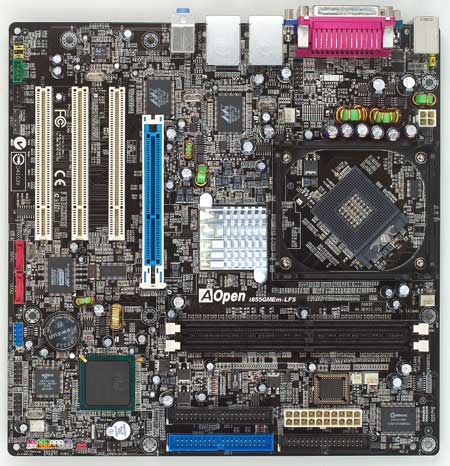
AOpen outfitted the board with dual GigE ports, both of which are placed on the back I/O panel above the four USB 2.0 ports.
The board only requires a 20-pin ATX power connector and a 4-pin +12V auxiliary connector like older Pentium 4 motherboards, although you can use a newer 24-pin PSU if you'd like.
Since AOpen uses ICH4-M, only parallel ATA is supported, so AOpen outfitted the board with a Promise SATA RAID controller to drive the two SATA ports on the board. AOpen also placed an Agere FireWire 400 controller on the board; however, they didn't supply the bracket to actually take advantage of the two ports supported by the controller.
The BIOS setup of the GMEm-LFS is pretty straightforward, although we definitely appreciated the layout of the overclocking options. The only complaint we had was that memory dividers weren't explicitly listed, which requires some math on the user's part to make sure that they're selecting the right memory speed when overclocking. The only voltage adjustments present on the board are for Vcore, which unfortunately tops out at 1.340V.
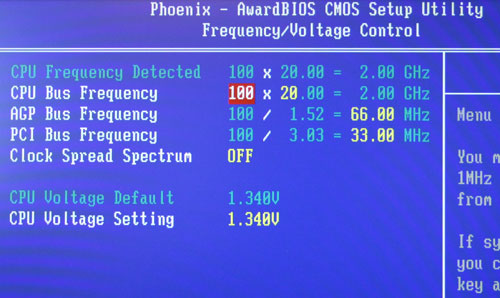
We had pretty decent overclocking success with the AOpen board and our Pentium M 755 (2.0GHz). Running it at 133MHz (533MHz FSB) x 18 at the maximum core voltage of 1.340V proved to be quite stable in all of our benchmarks. We could get the Pentium M to POST at 2.53GHz, but it wasn't stable enough to run our benchmarks.
Unfortunately, the biggest problem with overclocking the AOpen (as well as the DFI) board was that you could hardly overclock the memory bus. Regardless of what type of DDR400 memory we used, the highest that we could get the memory bus to run (stable) was 355MHz using the 4:3 memory divider.
Given how bandwidth-starved the Pentium M is, we were hoping for better overclocking success in the memory department, but were met with disappointment. The problem appears to be related to the 855GME chipset, as the DFI board suffered the same fate as the AOpen board.
So, while there's headroom in the CPUs (even our 1.7GHz Pentium Ms had no problems running above 2.0GHz), it seems like the chipsets/motherboards will limit the extent to which you can overclock.
The AOpen GMEm-LFS currently sells for $230.
DFI 855GME-MGF
The DFI 855GME-MGF was originally designed for a customer who needed PCI-X support, so DFI used a server version of ICH5 that provided both PCI-X and SATA support (FWE6300ESB). The server ICH obviously contributes to the price of the board, but from what we've seen, the DFI board only commands a $10 price premium over the AOpen board.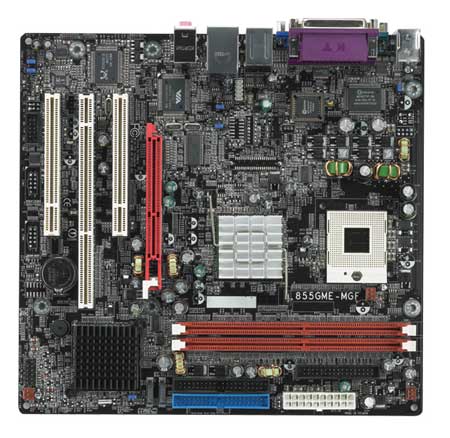
Since it's based on the 855GME chipset, the board obviously features integrated video - but the performance is nothing to write home about. Unlike AOpen's board, there's only a single 10/100/1000 GigE port, but on the 855GME-MGF, you get a single FireWire 400 port on the I/O panel as well (instead of through a separate connector).
The 855GME-MGF only needs a 20-pin ATX power connector and no auxillary 4-pin +12V connector (unlike the AOpen board). The problem with DFI's layout, however, is the placement of a capacitor next to the 20-pin ATX power connector, which means that you can't use a 24-pin PSU with the board unless you have an adapter as the capacitor that won't let the additional 4 pins overhang.
The BIOS of the 855GME-MGF is very similar to the AOpen board in terms of options, but the actual layout for overclocking in the BIOS isn't as intuitive as it was on the AOpen board.
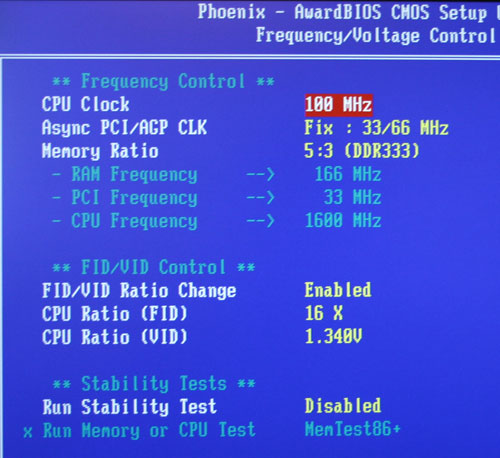
The stability of the DFI board was nothing to complain about, although it was far more sensitive to memory overclocking than the AOpen board was. When overclocked to the same levels that we were able to achieve on the AOpen board, the 855GME-MGF would randomly not POST between reboots. Usually a quick reboot would fix the problem, but it's still something that we'd rather not deal with. While we could easily hit 2.4GHz on the AOpen board, we found that 2.26GHz was the only stable overclock that we could achieve on the DFI motherboard (with all other variables, such as memory speed, the same).
The voltage adjustments are equally as disappointing on the 855GME-MGF. You can only adjust Vcore up to a maximum of 1.340V. And just like the AOpen board, although the 855GME-MGF only officially supports the 400MHz FSB, reaching 533MHz isn't a problem at all.
DFI's cooling solution is a little different from AOpen's, as they include a smaller but taller heatsink that screws on to a backplate. Both DFI and AOpen's fans were similarly quiet. AOpen's heatsink relied on thermal grease to improve heat transfer, while DFI's solution has a layer of thermal conductive material already on the base of the heatsink. The advantage to AOpen's method of just supplying thermal grease is that it's easier to reapply if you switch CPUs often, rather than the material that's present on the DFI heatsink.
Overall, the DFI is just as capable of a board as AOpen's solution, and is the only solution that offers a PCI-X slot if that matters to you. However, the BIOS layout, reduced stability when overclocking, and a slightly higher price point give the nod to AOpen for our overall recommendation.
The DFI 855GME-MGF currently sells for $239.
The Test
Our hardware configurations are similar to what we've used in previous comparisons.AMD Athlon 64 Configuration
Socket-939 Athlon 64 CPUs2 x 512MB OCZ PC3200 EL Dual Channel DIMMs 2-2-2-10
NVIDIA nForce4 Reference Motherboard
ATI Radeon X800 XT PCI Express
Intel Pentium 4 Configuration
LGA-775 Intel Pentium 4 and Extreme Edition CPUs2 x 512MB Crucial DDR-II 533 Dual Channel DIMMs 3-3-3-12
Intel 925XE Motherboard
ATI Radeon X800 XT PCI Express
Intel Pentium M Configuration
Intel Pentium M 725 - 7552 x 512MB OCZ PC3200 EL Dual Channel DIMMs 2-2-2-10
AOpen GMEm-LFS Motherboard ATI Radeon X800 XT AGP
Business/General Use Performance
Business Winstone 2004
Business Winstone 2004 tests the following applications in various usage scenarios:- Microsoft Access 2002
- Microsoft Excel 2002
- Microsoft FrontPage 2002
- Microsoft Outlook 2002
- Microsoft PowerPoint 2002
- Microsoft Project 2002
- Microsoft Word 2002
- Norton AntiVirus Professional Edition 2003
- WinZip 8.1

In business applications, the Pentium M does extremely well - with the 755 offering performance equivalent to that of an Athlon 64 FX-55. This is undoubtedly due to the extremely low latency L2 cache, which matters considerably in business applications.
Office Productivity SYSMark 2004
SYSMark's Office Productivity suite consists of three tests, the first of which is the Communication test. The Communication test consists of the following:"The user receives an email in Outlook 2002 that contains a collection of documents in a zip file. The user reviews his email and updates his calendar while VirusScan 7.0 scans the system. The corporate web site is viewed in Internet Explorer 6.0. Finally, Internet Explorer is used to look at samples of the web pages and documents created during the scenario."
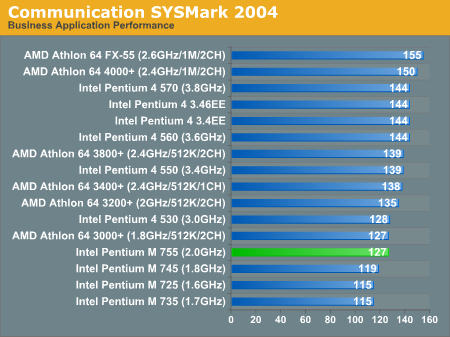
Immediately, we see that the Pentium M can't always do well, as even the 2.0GHz Pentium M 755 can't outperform the Athlon 64 3000+. The communication suite stresses memory bandwidth and latency rather than applications and usage patterns that fit into cache, so the Pentium M loses out big time.
The next test is Document Creation performance, which shows very little difference in drive performance between the contenders:
"The user edits the document using Word 2002. He transcribes an audio file into a document using Dragon NaturallySpeaking 6. Once the document has all the necessary pieces in place, the user changes it into a portable format for easy and secure distribution using Acrobat 5.0.5. The user creates a marketing presentation in PowerPoint 2002 and adds elements to a slide show template."
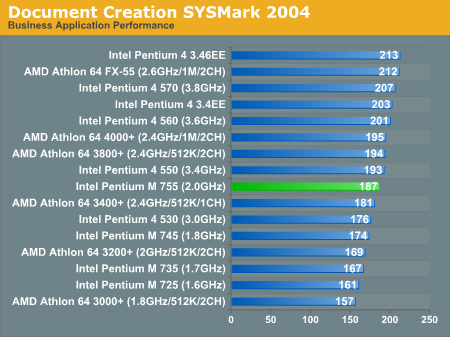
The Pentium M does a bit better in the document creation tests, as they are mostly using applications that will fit within the CPU's cache. However, the introduction of a voice recognition program into the test stresses the Pentium M's floating point performance, which does hamper its abilities here.
The final test in our Office Productivity suite is Data Analysis, which BAPCo describes as:
"The user opens a database using Access 2002 and runs some queries. A collection of documents are archived using WinZip 8.1. The queries' results are imported into a spreadsheet using Excel 2002 and are used to generate graphical charts."
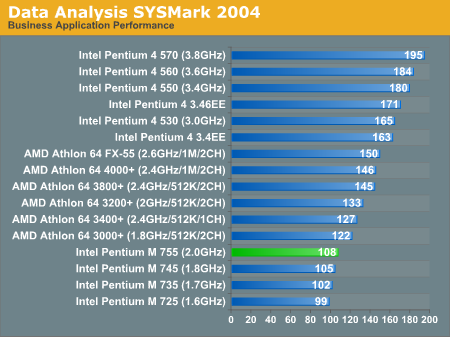
Without a doubt, the inclusion of Access usage patterns in the data analysis suite kills the Pentium M's chances here, as it once again brings up the tail in performance.
Microsoft Office XP SP-2
Here, we see in that the purest of office application tests, performance doesn't vary all too much.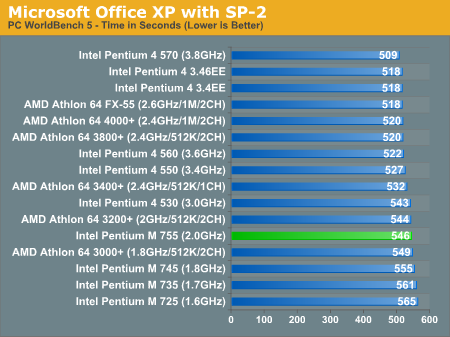
The Pentium M is competitive here, but so are all of the other CPUs.
Mozilla 1.4
Quite possibly the most frequently used application on any desktop is the one that we pay the least amount of attention when it comes to performance. While a bit older than the core that is now used in Firefox, performance in Mozilla is worth looking at as many users are switching from IE to a much more capable browser on the PC - Firefox.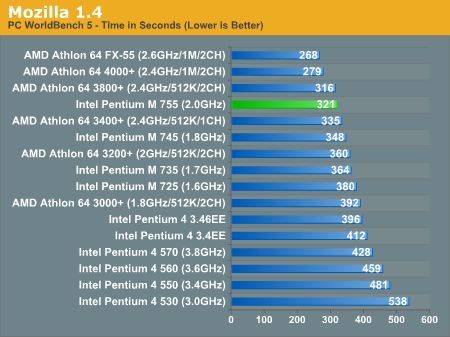
The Pentium M does extremely well here, outperforming both Athlon 64 and Pentium 4 competitors. Only the higher clock speed of the Athlon 64 gives it the overall lead here.
ACD Systems ACDSee PowerPack 5.0
ACDSee is a popular image editing tool that is great for basic image editing options such as batch resizing, rotating, cropping and other such features that are too elementary to justify purchasing something as powerful as Photoshop. There are no extremely complex filters here, just pure batch image processing.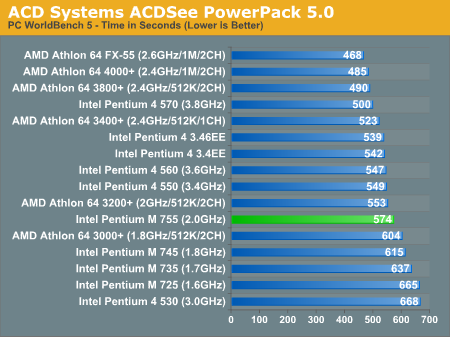
Once again, we see the Pentium M bring up the rear in situations where its low latency L2 cache can't help it.
Winzip
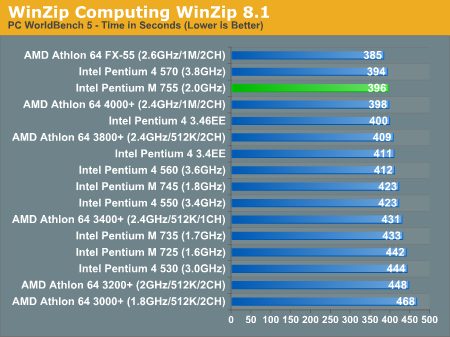
The Pentium M is fairly competitive in the real-world WinZip test - coming in third place overall, but the margin of victory isn't too great.
Let's look at how its peak theoretical performance is under WinRAR's built in benchmark:
WinRAR 3.40
Pulling the hard disk out of the equation, we can get a much better idea of which processors are truly best suited for file compression.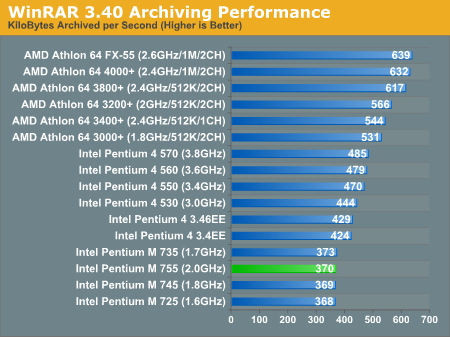
Here, we see that the lack of memory bandwidth really hurts the performance potential of the Pentium M. Luckily, most archiving tasks are usually disk-limited, so the performance differential won't be this bad in reality.
Multitasking Content Creation
MCC Winstone 2004
Multimedia Content Creation Winstone 2004 tests the following applications in various usage scenarios:- Adobe® Photoshop® 7.0.1
- Adobe® Premiere® 6.50
- Macromedia® Director MX 9.0
- Macromedia® Dreamweaver MX 6.1
- Microsoft® Windows MediaTM Encoder 9 Version 9.00.00.2980
- NewTek's LightWave® 3D 7.5b
- SteinbergTM WaveLabTM 4.0f
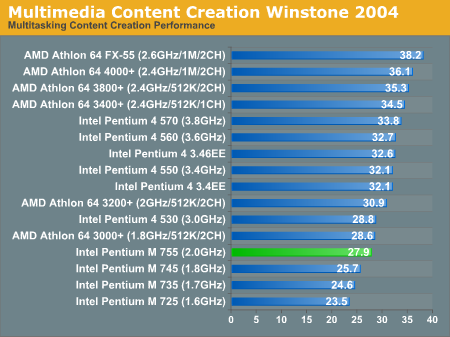
The more memory bandwidth and FP intensive MCC applications give the Pentium M a hard time, as it falls to the bottom of the performance charts.
ICC SYSMark 2004
The first category that we will deal with is 3D Content Creation. The tests that make up this benchmark are described below:"The user renders a 3D model to a bitmap using 3ds max 5.1, while preparing web pages in Dreamweaver MX. Then the user renders a 3D animation in a vector graphics format."
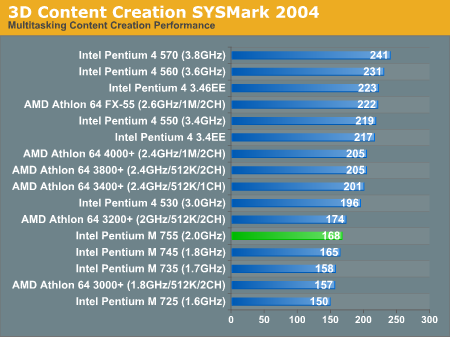
The Pentium M continues to perform dismally in content creation applications.
Next, we have 2D Content Creation performance:
"The user uses Premiere 6.5 to create a movie from several raw input movie cuts and sound cuts and starts exporting it. While waiting on this operation, the user imports the rendered image into Photoshop 7.01, modifies it and saves the results. Once the movie is assembled, the user edits it and creates special effects using After Effects 5.5."
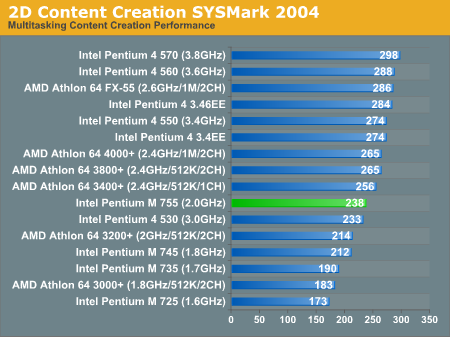
Things are a little better in the 2D content creation world, with the Pentium M performing on the lower end of the middle of the pack.
The Internet Content Creation suite is rounded up with a Web Publishing performance test:
"The user extracts content from an archive using WinZip 8.1. Meanwhile, he uses Flash MX to open the exported 3D vector graphics file. He modifies it by including other pictures and optimizes it for faster animation. The final movie with the special effects is then compressed using Windows Media Encoder 9 series in a format that can be broadcast over broadband Internet. The web site is given the final touches in Dreamweaver MX and the system is scanned by VirusScan 7.0."
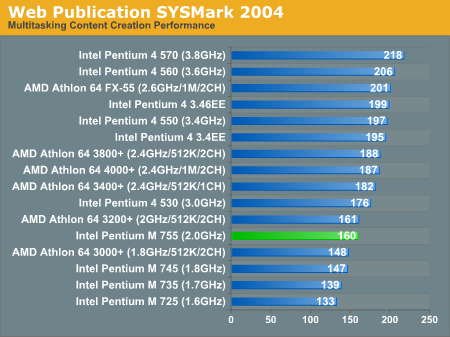
Once again, we have another situation where the Pentium M can't cut it on the desktop compared to its faster counterparts.
Mozilla + Media Encoder
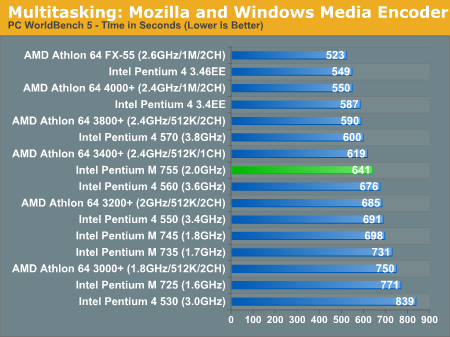
The Pentium M isn't very strong in media encoding applications, and thus, we don't see such solid performance here, thanks to its relatively weak FPU.
Video Creation/Photo Editing
Adobe Photoshop 7.0.1

Adobe Premier 6.5
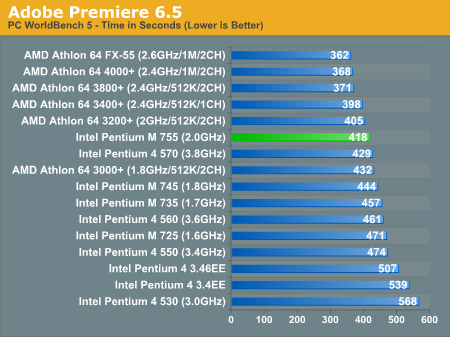
Roxio VideoWave Movie Creator 1.5
While Premier is a wonderful professional application, consumers will prefer something a little easier to use. Enter Roxio's VideoWave Movie Creator - a fairly full-featured, yet consumer level, video editing package.
Although the Pentium M was fairly competitive in Premier, the situation changes drastically once we look at VideoWave.
Audio/Video Encoding
MusicMatch Jukebox 7.10
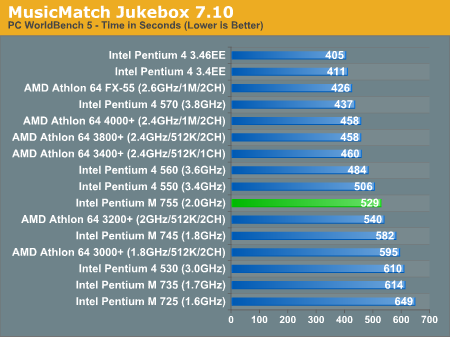
DivX 5.2.1 with AutoGK
Armed with DivX 5.2.1 and the AutoGK front end for Gordian Knot, we took all of the processors to task at encoding a chapter out of Pirates of the Caribbean. We set AutoGK to give us 75% quality of the original DVD rip and did not encode audio.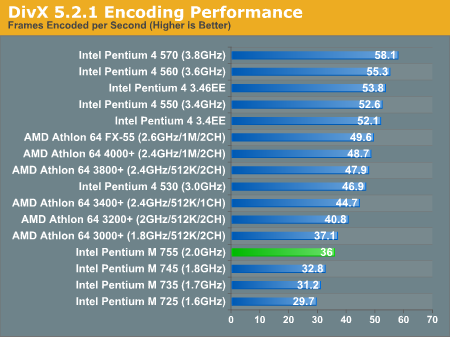
Video encoding is very memory bandwidth and FP intensive and does not benefit much from a low latency or large cache, thus we see that all of the Pentium M's weaknesses are exploited and its performance suffers accordingly.
XviD 5 with AutoGK
Another very popular codec is the XviD codec, and so, we measured encoding performance using it instead of DivX for this next test. The rest of the variables remained the same as the DivX test.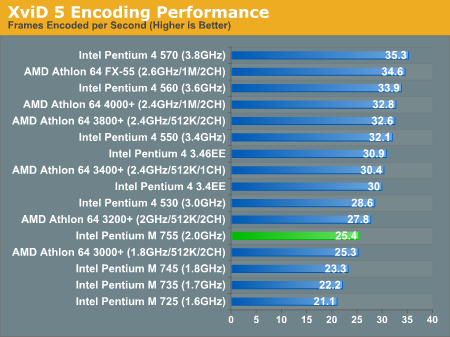
The same results are echoed in the XviD test.
Windows Media Encoder 9
To finish up our look at Video Encoding performance, we have two tests both involving Windows Media Encoder 9. The first test is WorldBench 5's WMV9 encoding test.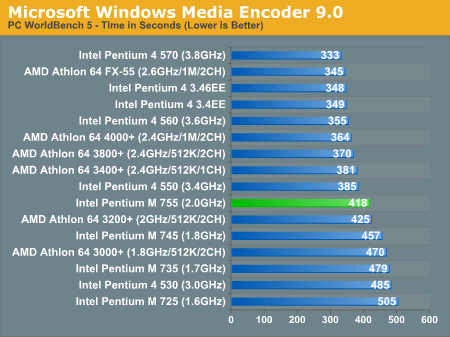
Next, we have our own home-brewed HD encoding test:
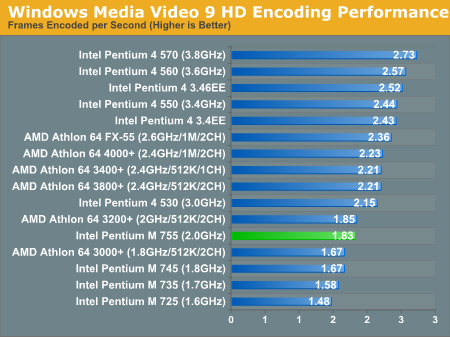
To summarize - the Pentium M doesn't have what it takes when it comes to media encoding.
Gaming Performance
The Pentium M offers reasonably strong gaming performance, more competitive than the Pentium 4, but at such a low clock speed, and more importantly, without the memory bandwidth to back it up - the Pentium M isn't as solid of a performer as it could be here.Doom 3

Halo
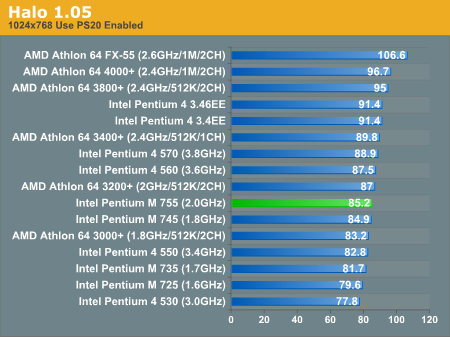
Unreal Tournament 2004
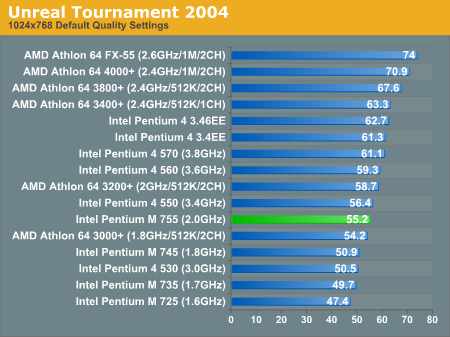
Wolfenstein: ET
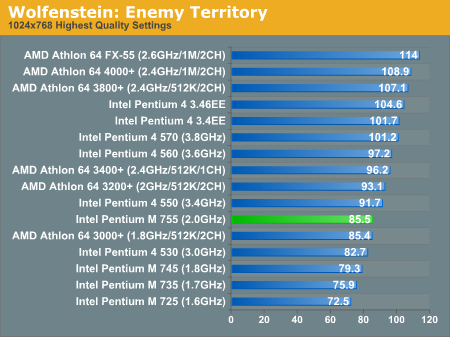
3D Rendering
3dsmax 5.1
WorldBench includes two 3dsmax benchmarks using version 5.1 of the popular 3D rendering and animation package: a DirectX and an OpenGL benchmark.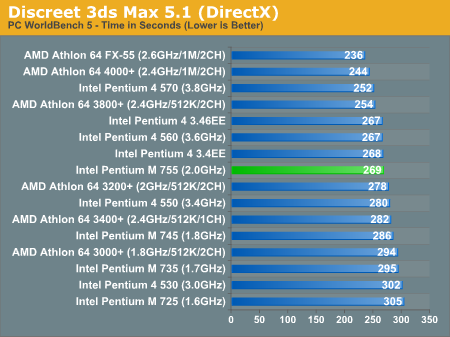
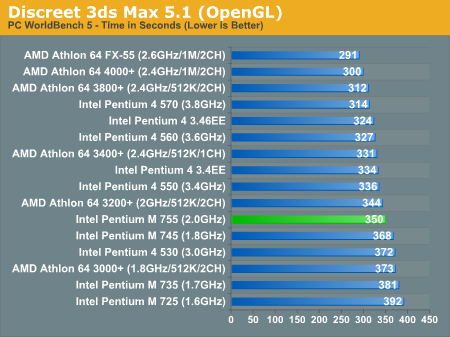
The Pentium M is reasonably competitive here, but let's see what happens when we look at a slightly beefier workload...
3dsmax 6
For the next 3dsmax test, we used version 6 of the program and ran the SPECapc rendering tests to truly stress these CPUs. The composite score is what matters, but we've included the individual scores that make it up as well for reference.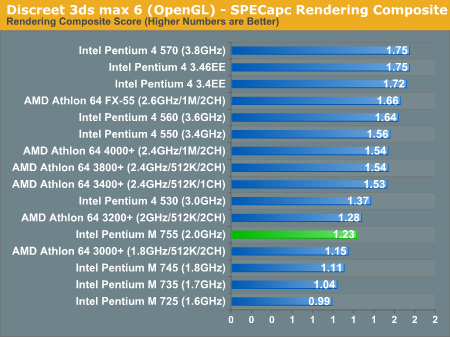
Here, the Pentium M just can't keep up.
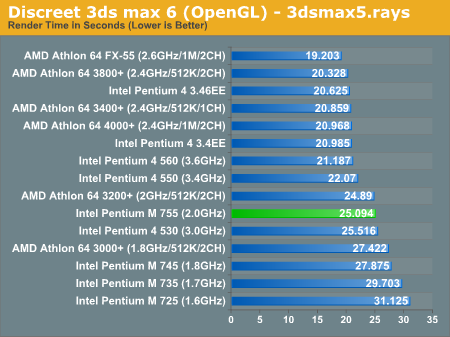

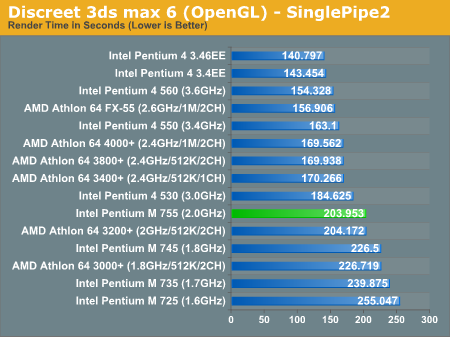
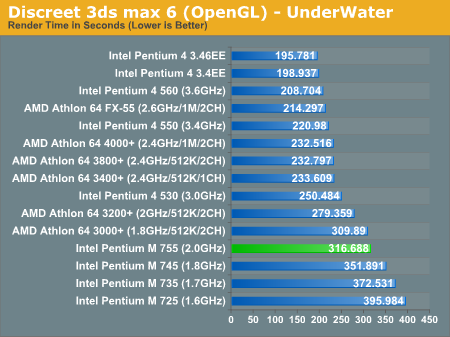
Workstation Applications
Visual Studio 6
Carried over from our previous CPU reviews, we continue to use Visual Studio 6 for a quick compile test. We are still using the Quake 3 source code as our test and measure compile time in seconds.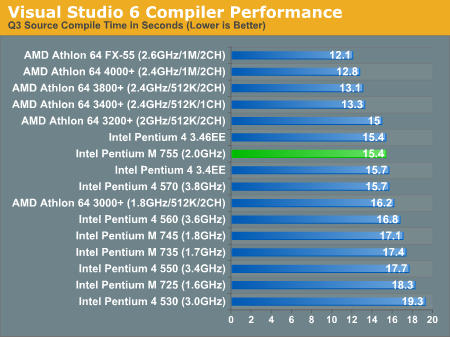
The Pentium M is very competitive with the Pentium 4 in our compiler test, but still not enough to compete with the Athlon 64.
SPECviewperf 8
For our next set of professional application benchmarks, we turn to SPECviewperf 8. SPECviewperf is a collection of application traces taken from some of the most popular professional applications, and compiled together in a single set of benchmarks used to estimate performance in the various applications that the benchmark is used to model. With version 8, SPEC has significantly improved the quality of the benchmark, making it even more of a real world indicator of performance.We have included SPEC's official description of each one of the 8 tests in the suite.
As you can guess, with the majority of performance in 3D workstation applications being determined by floating point performance and memory bandwidth, the Pentium M doesn't fare too well:
3dsmax Viewset (3dsmax-03)
"The 3dsmax-03 viewset was created from traces of the graphics workload generated by 3ds max 3.1. To ensure a common comparison point, the OpenGL plug-in driver from Discreet was used during tracing.
The models for this viewset came from the SPECapc 3ds max 3.1 benchmark. Each model was measured with two different lighting models to reflect a range of potential 3ds max users. The high-complexity model uses five to seven positional lights as defined by the SPECapc benchmark and reflects how a high-end user would work with 3ds max. The medium-complexity lighting models use two positional lights, a more common lighting environment.
The viewset is based on a trace of the running application and includes all the state changes found during normal 3ds max operation. Immediate-mode OpenGL calls are used to transfer data to the graphics subsystem."
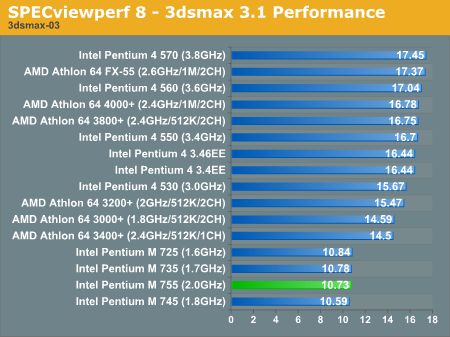
CATIA Viewset (catia-01)
"The catia-01 viewset was created from traces of the graphics workload generated by the CATIATM V5R12 application from Dassault Systems.
Three models are measured using various modes in CATIA. Phil Harris of LionHeart Solutions, developer of CATBench2003, supplied SPEC/GPC with the models used to measure the CATIA application. The models are courtesy of CATBench2003 and CATIA Community.
The car model contains more than two million points. SPECviewperf replicates the geometry represented by the smaller engine block and submarine models to increase complexity and decrease frame rates. After replication, these models contain 1.2 million vertices (engine block) and 1.8 million vertices (submarine).
State changes as made by the application are included throughout the rendering of the model, including matrix, material, light and line-stipple changes. All state changes are derived from a trace of the running application. The state changes put considerably more stress on graphics subsystems than the simple geometry dumps found in older SPECviewperf viewsets.
Mirroring the application, draw arrays are used for some tests and immediate mode used for others."
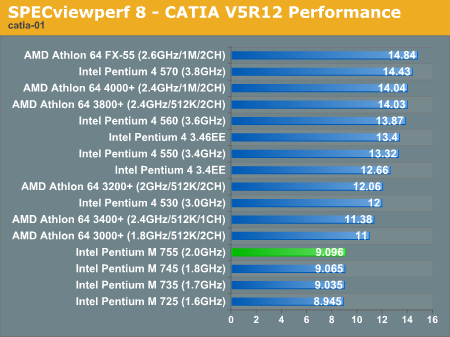
Lightscape Viewset (light-07)
"The light-07 viewset was created from traces of the graphics workload generated by the Lightscape Visualization System from Discreet Logic. Lightscape combines proprietary radiosity algorithms with a physically based lighting interface.
The most significant feature of Lightscape is its ability to simulate global illumination effects accurately by precalculating the diffuse energy distribution in an environment and storing the lighting distribution as part of the 3D model. The resulting lighting "mesh" can then be rapidly displayed."
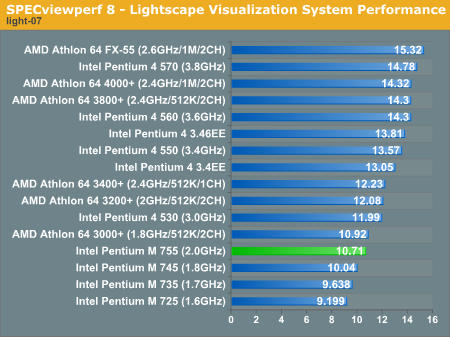
Maya Viewset (maya-01)
"The maya-01 viewset was created from traces of the graphics workload generated by the Maya V5 application from Alias.
The models used in the tests were contributed by artists at NVIDIA. Various modes in the Maya application are measured.
State changes as made by the application are included throughout the rendering of the model, including matrix, material, light and line-stipple changes. All state changes are derived from a trace of the running application. The state changes put considerably more stress on graphics subsystems than the simple geometry dumps found in older viewsets.
As in the Maya V5 application, array element is used to transfer data through the OpenGL API."
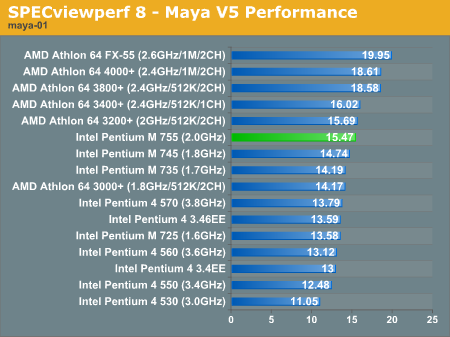
Pro/ENGINEER (proe-03)
"The proe-03 viewset was created from traces of the graphics workload generated by the Pro/ENGINEER 2001TM application from PTC.
Two models and three rendering modes are measured during the test. PTC contributed the models to SPEC for use in measurement of the Pro/ENGINEER application. The first of the models, the PTC World Car, represents a large-model workload composed of 3.9 to 5.9 million vertices. This model is measured in shaded, hidden-line removal, and wireframe modes. The wireframe workloads are measured both in normal and antialiased mode. The second model is a copier. It is a medium-sized model made up of 485,000 to 1.6 million vertices. Shaded and hidden-line-removal modes were measured for this model.
This viewset includes state changes as made by the application throughout the rendering of the model, including matrix, material, light and line-stipple changes. The PTC World Car shaded frames include more than 100MB of state and vertex information per frame. All state changes are derived from a trace of the running application. The state changes put considerably more stress on graphics subsystems than the simple geometry dumps found in older viewsets.
Mirroring the application, draw arrays are used for the shaded tests and immediate mode is used for the wireframe. The gradient background used by the Pro/E application is also included to better model the application workload."

SolidWorks Viewset (sw-01)
"The sw-01 viewset was created from traces of the graphics workload generated by the Solidworks 2004 application from Dassault Systemes.
The model and workloads used were contributed by Solidworks as part of the SPECapc for SolidWorks 2004 benchmark.
State changes as made by the application are included throughout the rendering of the model, including matrix, material, light and line-stipple changes. All state changes are derived from a trace of the running application. The state changes put considerably more stress on graphics subsystems than the simple geometry dumps found in older viewsets.
Mirroring the application, draw arrays are used for some tests and immediate mode used for others."

Unigraphics (ugs-04)
"The ugs-04 viewset was created from traces of the graphics workload generated by Unigraphics V17.
The engine model used was taken from the SPECapc for Unigraphics V17 application benchmark. Three rendering modes are measured -- shaded, shaded with transparency, and wireframe. The wireframe workloads are measured both in normal and anti-alised mode. All tests are repeated twice, rotating once in the center of the screen and then moving about the frame to measure clipping performance.
The viewset is based on a trace of the running application and includes all the state changes found during normal Unigraphics operation. As with the application, OpenGL display lists are used to transfer data to the graphics subsystem. Thousands of display lists of varying sizes go into generating each frame of the model.
To increase model size and complexity, SPECviewperf 8.0 replicates the model two times more than the previous ugs-03 test."
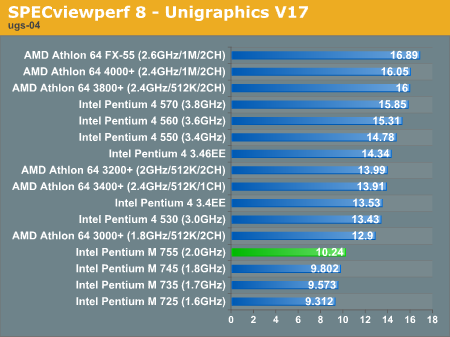
Overclocking to Save the Day?
Of course, the big question is - "What if you overclock it?"As you can expect, the Pentium M benefits greatly from being overclocked; not necessarily from the CPU being overclocked, but from the memory bus being overclocked. Unfortunately, as we mentioned before, the 855GME chipset and the two motherboards that we have based on it don't seem to want to overclock the memory bus too much, so we're left with somewhat nice performance gains from overclocking, but not ideal.
The problem with overclocking just the Pentium M is that it paints a skewed picture of reality - as comparing one overclocked processor to a ton of stock-clocked CPUs isn't really fair. But folks are always interested to see what an overclocked Pentium M can do, so we're here to show it off.
The beauty of the current Dothan based Pentium M CPUs is that they are 90nm chips, but without the heat issues of the Prescott based Pentium 4, meaning that they should overclock reasonably well. And overclock they do - our 2.0GHz sample easily hit 2.40GHz (133MHz x 18), and our 1.7GHz samples had no troubles getting up to 2.0GHz (one even hit 2.26GHz). We'd see bigger performance gains if we could bump up the memory clock beyond the 355MHz (to which we were limited), but that will most likely have to wait for new motherboards/chipsets.
Here are some abridged performance results with the overclocked Pentium M included:
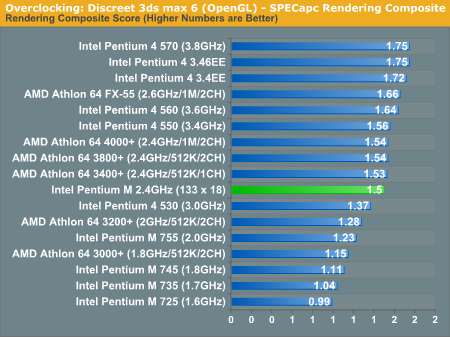
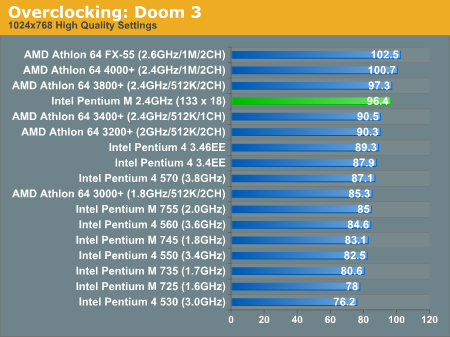
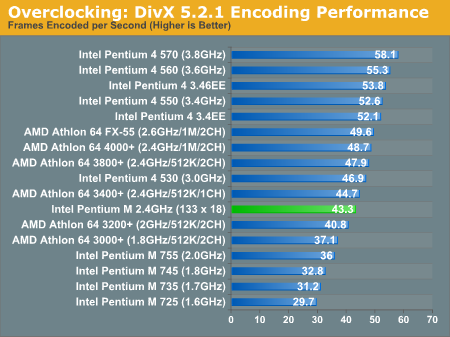
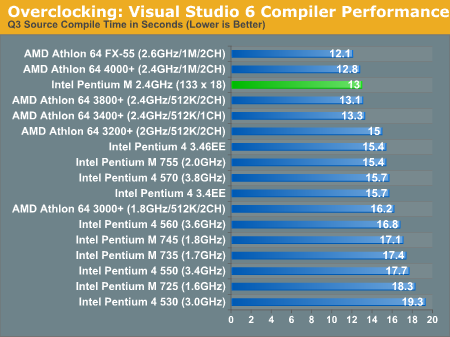
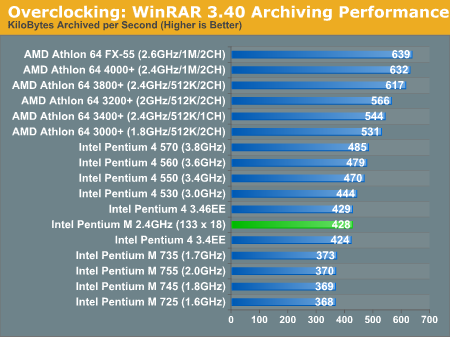
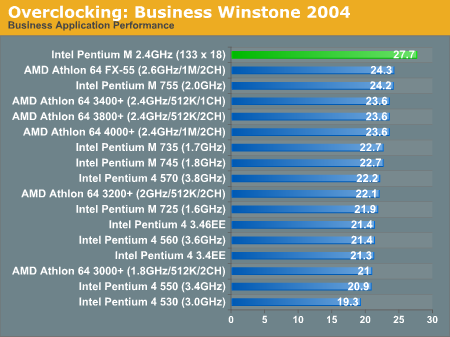
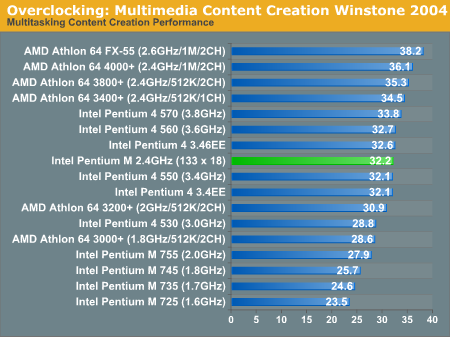
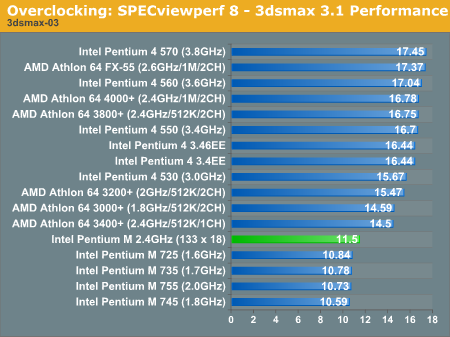
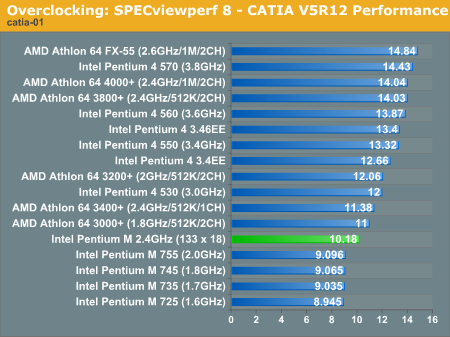

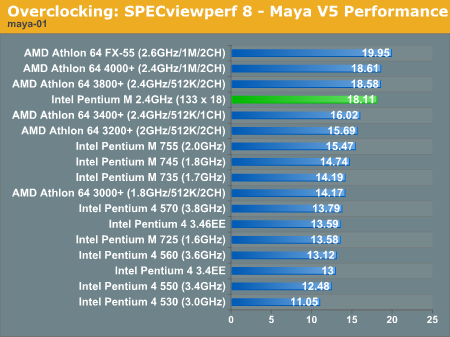
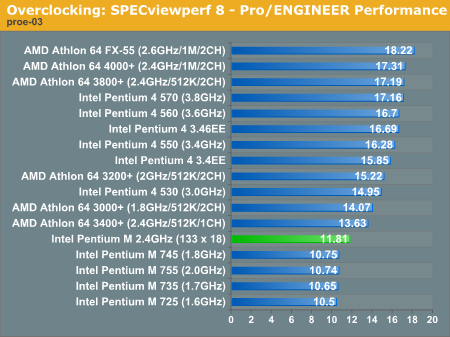
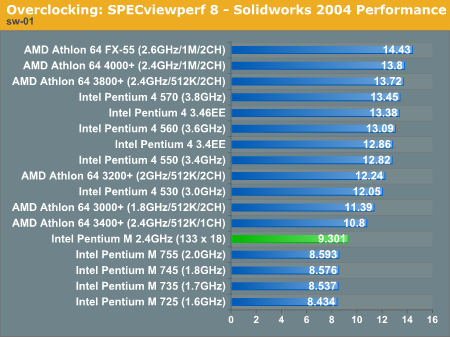
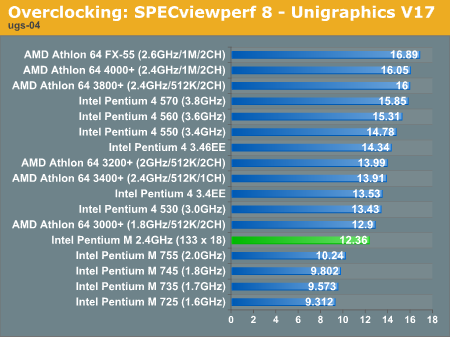
Price based Performance Comparison
To make it easier to digest all of the numbers, we've done a couple of head-to-head comparisons that help paint a more complete picture of the Pentium M's desktop performance.The first, and most important, comparison from a consumer standpoint is the price-based performance comparison - pitting the Pentium M against equivalently-priced desktop CPUs.
At $430 the Pentium 4 560 (3.6GHz) is the perfect competitor for the $435 Pentium M 755 (2.0GHz). So, let's see how the two stack up:
| Business/General Use | |||
| Intel Pentium 4 560 | Intel Pentium M 755 | Performance Advantage | |
| Business Winstone 2004 | 21.4 | 24.2 | 13% (Pentium M) |
| SYSMark 2004 - Communication | 137 | 127 | 8% (Pentium 4) |
| SYSMark 2004 - Document Creation | 201 | 187 | 7% (Pentium 4) |
| SYSMark 2004 - Data Analysis | 184 | 108 | 70% (Pentium 4) |
| Microsoft Office XP with SP-2 | 522 | 546 | 4% (Pentium 4) |
| Mozilla 1.4 | 459 | 321 | 30% (Pentium M) |
| ACD Systems ACDSee PowerPack 5.0 | 547 | 574 | 5% (Pentium 4) |
| Ahead Software Nero Express 6.0.0.3 | 545 | 510 | 6% (Pentium M) |
| WinZip Computing WinZip 8.1 | 412 | 396 | 4% (Pentium M) |
| WinRAR | 479 | 370 | 29% (Pentium 4) |
| Winner | - | - | Pentium 4 |
Under business applications, the Pentium M does fairly well, winning four benchmarks, but the Pentium 4 560 comes ahead with 6 total wins and a higher average win percentage. It is noteworthy to point out the Pentium M's victory in Business Winstone 2004, which is due to its low latency L2 cache, something that the Pentium 4 most definitely lacks.
Multitasking Content Creation
| Multitasking Content Creation | |||
| Intel Pentium 4 560 (3.6GHz) | Intel Pentium M 755 (2.0GHz) | Performance Advantage | |
| Content Creation Winstone 2004 | 32.7 | 27.9 | 17% (Pentium 4) |
| SYSMark 2004 - 3D Creation | 231 | 168 | 38% (Pentium 4) |
| SYSMark 2004 - 2D Creation | 288 | 238 | 21% (Pentium 4) |
| SYSMark 2004 - Web Publication | 206 | 160 | 29% (Pentium 4) |
| Mozilla and Windows Media Encoder | 676 | 641 | 5% (Pentium M) |
| Winner | - | - | Pentium 4 |
In multitasking content creation applications, the clear win goes to the Pentium 4 with much larger margins of victory in applications that stress FP performance as well as memory bandwidth.
Video Creation/Photo Editing
| Video Creation/Photo Editing | |||
| Intel Pentium 4 560 (3.6GHz) | Intel Pentium M 755 (2.0GHz) | Performance Advantage | |
| Adobe Photoshop 7.0.1 | 342 | 332 | 3% (Pentium M) |
| Adobe Premiere 6.5 | 461 | 418 | 9% (Pentium M) |
| Roxio VideoWave Movie Creator 1.5 | 287 | 411 | 30% (Pentium 4) |
| Winner | - | - | Pentium 4 |
The Pentium M is surprisingly competitive in Adobe Photoshop and Premier, but clearly loses to the Pentium 4 in the VideoWave test. With more and more video editing applications being optimized for the Pentium 4's architecture, at this point, we'd give the win to the Pentium 4 here as well.
Audio/Video Encoding
| Audio/Video Encoding | |||
| Intel Pentium 4 560 (3.6GHz) | Intel Pentium M 755 (2.0GHz) | Performance Advantage | |
| MusicMatch Jukebox 7.10 | 484 | 529 | 9% (Pentium 4) |
| DivX Encoding | 55.3 | 36 | 54% (Pentium 4) |
| XviD Encoding | 33.9 | 25.4 | 33% (Pentium 4) |
| Microsoft Windows Media Encoder 9.0 | 2.57 | 1.83 | 40% (Pentium 4) |
| Winner | - | - | Pentium 4 |
Although audio encoding paints the Pentium M in a competitive light, look at any of the video encoding tests and it's obvious that the Pentium M isn't in the same league as the Pentium 4 on a price competitive basis.
Gaming
| Gaming | |||
| Intel Pentium 4 560 (3.6GHz) | Intel Pentium M 755 (2.0GHz) | Performance Advantage | |
| Doom 3 | 84.6 | 85 | Tie |
| Halo | 87.5 | 85.2 | 3% (Pentium 4) |
| UT2004 | 59.3 | 55.2 | 7% (Pentium 4) |
| Wolfenstein: ET | 97.2 | 85.5 | 14% (Pentium 4) |
| Winner | - | - | Pentium 4 |
Gaming performance is pretty close, but the Pentium 4 does take the slight lead in some games.
3D Rendering
| 3D Rendering | |||
| Intel Pentium 4 560 (3.6GHz) | Intel Pentium M 755 (2.0GHz) | Performance Advantage | |
| Discreet 3dsmax 5.1 (DX) | 268 | 269 | Tie |
| Discreet 3dsmax 5.1 (OGL) | 327 | 350 | 7% (Pentium 4) |
| SPECapc 3dsmax 6 | 1.64 | 1.23 | 33% (Pentium 4) |
| Winner | - | - | Pentium 4 |
As we've already seen, FP performance is not a strongpoint of the Pentium M when compared to higher clocked Pentium 4s - which is why we see the Pentium 4 with such a strong lead in the 3dsmax 6 test.
Professional Applications
| Professional Applications | |||
| Intel Pentium 4 560 (3.6GHz) | Intel Pentium M 755 (2.0GHz) | Performance Advantage | |
| SPECviewperf 8 - 3dsmax-03 | 17.04 | 10.73 | 59% (Pentium 4) |
| SPECviewperf 8 - catia-01 | 13.87 | 9.096 | 52% (Pentium 4) |
| SPECviewperf 8 - light-07 | 14.3 | 10.71 | 34% (Pentium 4) |
| SPECviewperf 8 - maya-01 | 13.12 | 15.47 | 18% (Pentium M) |
| SPECviewperf 8 - proe-03 | 16.7 | 10.74 | 55% (Pentium 4) |
| SPECviewperf 8 - sw-01 | 13.09 | 8.593 | 52% (Pentium 4) |
| SPECviewperf 8 - ugs-04 | 15.31 | 10.24 | 50% (Pentium 4) |
| Winner | - | - | Pentium 4 |
The SPECviewperf 8 suite stresses both FP performance and memory bandwidth, so the results here are not surprising at all - the Pentium M isn't a workstation class processor either.
Pentium M vs. Pentium 4 Price Based Comparison Conclusion
At the same price, the Pentium 4 560 is a much better deal than the Pentium M 755, regardless of application suite. Also remember that we're not taking into account motherboard cost in this comparison, which makes the Pentium M 755 about $100 more expensive on the desktop.The Pentium M does produce a lot less heat than the Pentium 4 560, which has to be worth something, right? Well, as we've shown in previous comparisons, the Athlon 64 3500+ is fairly competitive with the Pentium 4 560, and if you get the new 90nm core, produces significantly less heat - making it the better option. You get the performance of the Pentium 4, but with thermal characteristics closer to the Pentium M.
Clock Speed based Performance Comparison
While the price-based performance comparison is the more practical comparison, a comparison based on clock speed is quite possibly the more interesting. We took an AMD Athlon 64 3200+ (Socket-939, 2.0GHz) and pitted it against our 2.0GHz Pentium M 755 to see how efficient Intel's mobile core happens to be.| Business/General Use | |||
| AMD Athlon 64 3200+ (2.0GHz) | Intel Pentium M 755 (2.0GHz) | Performance Advantage | |
| Business Winstone 2004 | 22.1 | 24.2 | 10% (Pentium M) |
| SYSMark 2004 - Communication | 134 | 127 | 6% (Athlon 64) |
| SYSMark 2004 - Document Creation | 169 | 187 | 11% (Pentium M) |
| SYSMark 2004 - Data Analysis | 133 | 108 | 23% (Athlon 64) |
| Microsoft Office XP with SP-2 | 544 | 546 | Tie |
| Mozilla 1.4 | 360 | 321 | 11% (Pentium M) |
| ACD Systems ACDSee PowerPack 5.0 | 553 | 574 | 4% (Athlon 64) |
| Ahead Software Nero Express 6.0.0.3 | 497 | 510 | 3% (Athlon 64) |
| WinZip Computing WinZip 8.1 | 448 | 396 | 12% (Pentium M) |
| WinRAR | 566 | 370 | 53% (Athlon 64) |
| Winner | - | - | AMD Athlon 64 3200+ |
The Pentium M is extremely competitive with the Athlon 64 in our business/general use tests, even outperforming it in four of the benchmarks. However, in tests where the Pentium M's 2MB L2 cache isn't enough, the Athlon 64 pulls ahead - such as the Data Analysis SYSMark 2004 test and the WinRAR test.
Multitasking Content Creation
| Multitasking Content Creation | |||
| AMD Athlon 64 3200+ (2.0GHz) | Intel Pentium M 755 (2.0GHz) | Performance Advantage | |
| Content Creation Winstone 2004 | 30.9 | 27.9 | 11% (Athlon 64) |
| SYSMark 2004 - 3D Creation | 174 | 168 | 4% (Athlon 64) |
| SYSMark 2004 - 2D Creation | 214 | 238 | 11% (Pentium M) |
| SYSMark 2004 - Web Publication | 161 | 160 | Tie |
| Mozilla and Windows Media Encoder | 685 | 641 | 6% (Pentium M) |
| Winner | - | - | Tie |
Surprisingly enough, the Athlon 64 and the Pentium M 755 give us a tie here. Content creation applications tend to be more memory bandwidth sensitive than not, so we were a bit surprised to see that the Pentium M did so well here, but it appears that the low latency L2 cache is able to make up for its lack of memory bandwidth. To AMD's credit, as applications increase in size, the Pentium M wouldn't be able to compete as well, but for present day applications, it's interesting to see the Pentium M do so well without the aid of AMD's on-die memory controller.
Video Creation/Photo Editing
| Video Creation/Photo Editing | |||
| AMD Athlon 64 3200+ (2.0GHz) | Intel Pentium M 755 (2.0GHz) | Performance Advantage | |
| Adobe Photoshop 7.0.1 | 364 | 332 | 8% (Pentium M) |
| Adobe Premiere 6.5 | 405 | 418 | 3% (Athlon 64) |
| Roxio VideoWave Movie Creator 1.5 | 349 | 411 | 15% (Athlon 64) |
| Winner | - | - | AMD Athlon 64 3200+ |
The race is fairly close here, but AMD pulls away in the two video editing tests.
Audio/Video Encoding
| Audio/Video Encoding | |||
| AMD Athlon 64 3200+ (2.0GHz) | Intel Pentium M 755 (2.0GHz) | Performance Advantage | |
| MusicMatch Jukebox 7.10 | 540 | 529 | 2% (Pentium M) |
| DivX Encoding | 40.8 | 36 | 13% (Athlon 64) |
| XviD Encoding | 27.8 | 25.4 | 10% (Athlon 64) |
| Microsoft Windows Media Encoder 9.0 | 1.85 | 1.83 | Tie |
| Winner | - | - | AMD Athlon 64 3200+ |
The Pentium 4 completely blew the Pentium M away in the video encoding tests and while the Athlon 64 also manages to outperform it, the margin of victory isn't nearly as great. With a faster memory bus, it is possible that the Pentium M could significantly lessen the gap. Regardless, the win still goes to the Athlon 64.
Gaming
| Gaming | |||
| AMD Athlon 64 3200+ (2.0GHz) | Intel Pentium M 755 (2.0GHz) | Performance Advantage | |
| Doom 3 | 90.3 | 85 | 6% (Athlon 64) |
| Halo | 87 | 85.2 | 2% (Athlon 64) |
| UT2004 | 58.7 | 55.2 | 6% (Athlon 64) |
| Wolfenstein: ET | 93.1 | 85.5 | 9% (Athlon 64) |
| Winner | - | - | AMD Athlon 64 3200+ |
Gaming performance is extremely close, but AMD takes the slight lead over the Pentium M.
3D Rendering
| 3D Rendering | |||
| AMD Athlon 64 3200+ (2.0GHz) | Intel Pentium M 755 (2.0GHz) | Performance Advantage | |
| Discreet 3dsmax 5.1 (DX) | 278 | 269 | 3% (Pentium M) |
| Discreet 3dsmax 5.1 (OGL) | 344 | 350 | 2% (Pentium M) |
| SPECapc 3dsmax 6 | 1.28 | 1.23 | 4% (Athlon 64) |
| Winner | - | - | Tie |
3D Rendering performance is even closer between these two, leaving us with a tie between the Athlon 64 and the Pentium M at the same clock speed.
Professional Applications
| Professional Applications | |||
| AMD Athlon 64 3200+ (2.0GHz) | Intel Pentium M 755 (2.0GHz) | Performance Advantage | |
| SPECviewperf 8 - 3dsmax-03 | 15.47 | 10.73 | 44% (Athlon 64) |
| SPECviewperf 8 - catia-01 | 12.06/strong> | 9.096 | 33% (Athlon 64) |
| SPECviewperf 8 - light-07 | 12.08 | 10.71 | 13% (Athlon 64) |
| SPECviewperf 8 - maya-01 | 15.69 | 15.47 | Tie |
| SPECviewperf 8 - proe-03 | 15.22 | 10.74 | 42% (Athlon 64) |
| SPECviewperf 8 - sw-01 | 12.24 | 8.593 | 42% (Athlon 64) |
| SPECviewperf 8 - ugs-04 | 13.99 | 10.24 | 37% (Athlon 64) |
| Winner | - | - | AMD Athlon 64 3200+ |
The SPECviewperf 8 suite goes to AMD, as the Athlon 64 completely dominates the Pentium M, clock for clock, in these very memory bandwidth, latency and FP intensive tests.
Pentium M vs. Athlon 64 Clock Speed Based Comparison Conclusion
While the Athlon 64 3200+ pulled away with the win in most of our test suites (tying twice), the Pentium M 755 put up a very hard fight. Given how strongly the Pentium M competes with the Athlon 64 on a clock for clock basis, the obvious answer would be to use the Pentium M to compete with AMD instead of the Pentium 4, right?Wrong. The fundamental issue is that although the Pentium M is surprisingly competitive with the Athlon 64 on a clock for clock basis, the Pentium M's architecture can't scale to the same clock speeds that the Athlon 64 can. The fact of the matter is that while the Pentium M will hit 2.26GHz by the end of 2005, the Athlon 64 will be on its way to 3.0GHz and beyond. It's the same argument that was present during the Pentium III vs. Pentium 4 transition period, and we all know the result of that transition.
The Pentium M's astounding successes against the Athlon 64, despite the lack of an on-die memory controller and only a single channel DDR333 memory bus, are without a doubt due to its 10 cycle L2 cache. We've seen how much a reduction in memory latency can do for performance - the Athlon 64 is a living, breathing example of that. But an even greater reduction in L2 cache latency is even more powerful under the right circumstances.
Final Words
As a mobile processor, the Pentium M cannot be beat - we've actually seen why, even in this comparison today. With a highly power optimized architecture, the Pentium M continues to deliver performance that is competitive with other mobile CPUs on the market. The problem is that in the transition to the desktop world, its competitors get much more powerful, while the Pentium M is forced to live within its mobile constraints.Think of it like this - the Pentium 4 and Athlon 64 are clearly the stronger chips of the three, as we have proved in today's review. However, in the mobile world, the Pentium 4 and Athlon 64 are often castrated or limited either by low clock speeds, single channel memory controllers or more physical constraints (e.g. you can get desktop P4 performance, but only in a 13lbs notebook). The Pentium M however, was designed from the ground up with these types of constraints in mind, and thus, excels quite well with them in place. Begin to remove the constraints and the Pentium M appears to be much less impressive compared to the Pentium 4 and Athlon 64 because the chip was designed to perform best with those constraints in place. The very low latency 2MB L2 cache is a prime example of this design mentality. A large L2 cache reduces the need for a high bandwidth memory bus, and making it low latency means that the CPU is even less dependent on such a bus.
The fact of the matter is that the Pentium M, while excellent as a mobile CPU, isn't the response from Intel that everyone is hoping for. The successor to the Pentium 4 won't be an architecture derived from the Pentium III, there's just no way around that. Intel has invested too much time and money into the optimization of applications for the Pentium 4 architecture and its execution core to throw it all away and revert to the old way of doing things.
That isn't to say that elements of the Pentium M design won't be included in Pentium 5 or whatever the next chip will be called. Even today's Pentium 4 already has a handful of key features borrowed from the Pentium M design. We saw examples of this with the launch of Prescott; the indirect branch predictor used in Prescott was originally introduced with the Pentium M processor. It would also be safe to say that a number of improvements that Intel is introducing in the next version of the Pentium M, the dual core Yonah, will eventually make their way into future Intel desktop CPUs as well.
But with a very high cost of ownership, thanks to high motherboard prices and correspondingly high CPU prices, not to mention a very limited upgrade path, the Pentium M just isn't suited for the desktop. And unless these deciding factors change significantly in the near future, it won't be for some time to come.







